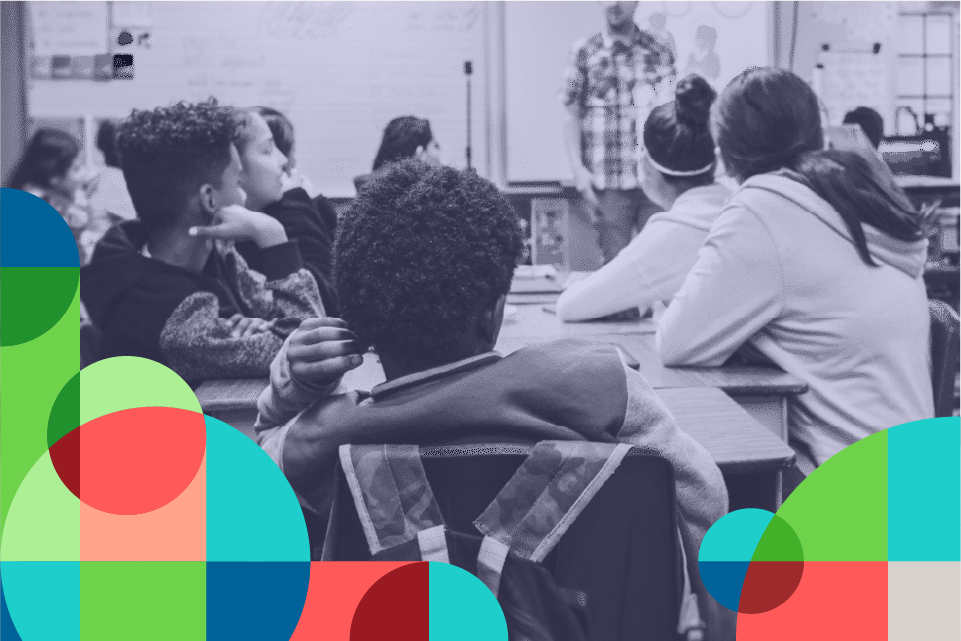New Mexico Tackles
Tutoring Challenges
in Rural Areas


New Mexico Public Education Department (NMPED) & Saga Education
New Mexico
2022-2024
Executive Summary
This case study explores broad-scale, high-impact tutoring (HIT) programs operated by Saga’s school system partners. Through interviews with program managers, we examine success factors and challenges. Saga supports districts with planning, launching, and implementing high-quality tutoring.
Key Takeaways
- Strong core math curriculum is essential for student success. High-impact tutoring can support weak core instruction, but shines when paired with a solid core program.
- Smaller student-to-tutor ratios are beneficial, with a 4:1 ratio being good for many students and even lower ratios for those needing more intensive support.
- High-impact tutoring goes beyond one-off lessons and focuses on active participation with the curriculum over time. It prioritizes a positive learning environment that builds student confidence.
- Students who received this high-impact tutoring learned 43% more in one year than similar students who did not receive it.
- Students received at least 90 minutes of tutoring per week for 32-36 weeks.
- 69% of students served are students of color, 15% are Native American students, and 17% are English Language Learners.
The Challenge
Faced with pandemic-related labor shortages and a large, rural population, the New Mexico Public Education Department (NMPED) opted for live-online tutoring to deliver their high-dosage tutoring program. This approach offered students flexibility by scheduling sessions outside the school day, including evenings and weekends.
Low Participation Highlights Need for Adjustment
Despite significant recruitment efforts by NMPED and the research team, participation in the live-online tutoring program needed to be higher. Only 1.5% (approximately 527 students) of the estimated 34,262 eligible students statewide signed up for these after-hours sessions. Rural students’ participation was also lower than their urban or suburban counterparts. Furthermore, only 62% of those who signed up participated in tutoring.
The Implementation
Learning from Experience: A Shift to In-School Tutoring
Recognizing the limitations of the initial model, NMPED has redesigned its high-dosage tutoring program for the current school year (SY23-24). This new iteration leverages live-online tutors but integrates them into the school day within monitored classrooms. This shift addresses the participation concerns and potentially reaches hundreds of students more consistently.
NMPED provided funds in two ways to support tutoring programs. Each participating school received $10,000 to aid its programs, and its site coordinators were additionally compensated $5,000 each. For live-online tutoring, participating schools used Google Meet which helped to foster a supportive and engaging learning environment for students of all backgrounds.
Below are a few schools that implemented live-online, high-impact tutoring with Saga Education:
Taos Municipal Charter School
Taos Municipal Charter School introduced high-impact tutoring content to their curriculum during study hall for the last 35 minutes of the school day. Teachers communicated with the tutors about the specific lesson content covered. Trained in the Saga Curriculum, teachers linked their lessons to the relevant Saga materials. Clear communication between teachers and tutors ensured students received additional support from the tutors after the initial lesson. Consequently, students benefited from prior knowledge of the material before entering tutoring sessions, allowing them to ask questions in a safe and supportive environment.
Taos Integrated School of the Arts
Taos Integrated School of the Arts implemented a high-impact tutoring program for their 6th-grade math class. The program provided a supportive environment with snacks and water to ensure students completed their homework. As a result, program managers noted a dramatic shift in student attitudes, with several claiming math as their favorite subject. This positive change has resulted in significant academic gains, with students seeing jumps of 20 to 30 points in their math scores on the NWEA MAPS short-cycle assessments.
Moreno Valley High School
Moreno Valley High School implemented a unique tutoring program where the teachers, not just math teachers, used Saga content to create a skill-driven tutoring curriculum aligned with grade-level standards and the units in the regular math class to provide high-impact tutoring to their students directly. The school made an extra math period for all 9th and 10th graders and saw a significant improvement in their math scores, with both grades performing 20 points ahead of the junior class on the NWEA MAPS short cycle assessments. Their implementation demonstrated how not only can students develop a love for math, but it can also lead to substantial improvement in their academic performance.
The Importance of a Strong Core Math Curriculum
Intense core instruction is essential for student success in math. It ensures all students progress at a steady pace and minimizes gaps in comprehension. Significant gaps in student math skills suggest possible disparities with core instruction delivery. These issues likely stemmed from the following:
- Lack of a Viable Teaching Curriculum: Schools may have needed a well-defined, practical curriculum.
- Teacher Shortage and Preparation: Teacher shortages can significantly inhibit effective and adequate curriculum delivery.
“The only thing stopping us from being a school of excellence is math. Our math has been the hardest part,” states Rich Greywolf, Director of the Taos Integrated School of the Arts. “One of those things is just finding good teachers. In the past three years, I’ve gone through three.”
High-impact tutoring can offer critical support even when core math instruction requires improvement. It allows students to engage with the material, regardless of the classroom situation. However, the program truly shines when paired with solid core instruction, aligned with grade-level standards and supporting students to meet academic expectations. In these cases, it is a powerful tool to solidify learning, maintain consistent practice, and prevent skills from fading over time.
“By revisiting and reinforcing key concepts, high-impact tutoring combats the natural forgetting curve,” states Michelle Korbakes, Accelerated Learning & Professional Development Project Manager, NMPED. In high-impact tutoring, we’re not giving students an opportunity to forget because we’re constantly [re-engaging them]. Students gain a deeper understanding that goes beyond rote memorization and sticks with them over time.”
Filling Gaps and Supporting Strong Core Programs
“One of my philosophies is that confidence is key for middle school math students, and confidence comes from having opportunities to share,” states Nathaniel Evans, Dean of Students at Taos Municipal Charter. “Students communicate with different voices, which is important in activating those connections. The tutors have different ways of connecting things. That’s where you get that diversity of learning that happens and the diversity of teaching.”
The Power of Smaller Tutoring Ratios:
Preliminary data highlighted the effectiveness of smaller student-to-tutor ratios, particularly for students needing more intensive support. Findings suggested:
- A 4:1 student-to-tutor ratio is beneficial for many students.
- Even lower ratios like 2:1 or 1:1 can benefit students requiring more intensive support.
“With middle schoolers, relationships are key to feeling safe and [taking] risks. Once you have those students taking risks, you start to see and hear that in the classroom: ‘Oh, yeah, my tutor showed me this way,’ and they start to share with the greater class. So the impact is this whole kind of dynamic learning and teaching setup that we have with students feeling safe.”
By implementing these strategies, gaps in core instruction were addressed, and positive feedback was shared with the schools to provide students with a better opportunity to thrive in math.
Educating Districts on Long-Term Benefits: More Than Just Homework Help
High-impact tutoring isn’t about a quick fix or one-off lessons. It’s a structured program delivered over time to make a real difference in student achievement. One key advantage is the smaller student-to-tutor ratio. This is different from a classroom of 25, where students with missed opportunities for learning can only quickly disengage. This focus leads to active participation and engagement with the curriculum.
“High-impact tutoring allowed us to focus on our work,” shared Tammy Dunn, Director of Moreno Valley High School. “Teachers work so hard, students work so hard, but we don’t see the results. We were so excited to start high-impact tutoring because we could do away with all the extraneous things and focus on a proven curriculum that produces results, [which] it did.”
Prioritizing a positive learning environment is critical for math tutoring success. Tutors personalize the experience using students’ names, fostering ownership and responsibility. This, along with the initial anxieties around math being replaced by a sense of accomplishment, builds confidence. Shared learning further reinforces this positivity, ultimately changing students’ perceptions of math and their abilities in other areas of life.
“We’re still working to communicate the program’s impact to school districts,” states Korbakes. “While they may understand the research and their busy schedules make implementation challenging, understandably, the key is to create dedicated space within the school day for high-impact tutoring.”
